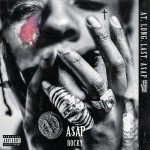
BY ALTUĞ KARAKURT (EE/III)
altug.karakurt@ug.bilkent.edu.tr
A few months ago I stumbled upon a brief article on the relevance of lyrical content in hip-hop music. The commentary revolved around two of the most popular hip-hop albums of the year, Kendrick Lamar’s “To Pimp a Butterfly” (TPAB) and A$AP Rocky’s “AT.LONG.LAST.A$AP” (ATLA). The first album is becoming the symbol of what I would like to call the second wave of conscious hip-hop, with the latter being one of the most popular, disposable entertainment releases of the year. I want to reflect on the comparison between lyrical, profound music and shallow entertainment, but first I need to introduce these artists and albums and explain why they were specifically chosen for this argument.
Kendrick Lamar has been the rising star of hip-hop ever since his first release. He is easily one of the most celebrated and influential artists of the genre. Kendrick’s 2011 debut, “Section.80,” instantly got the attention of the hip-hop community and became a very hot release. The album was filled with creative, personal lyrics, as well as a socially aware attitude, which hadn’t been mainstream for over a decade. This record was far from being perfect but, with its characteristic style, proved Kendrick’s potential.
 A year later, Kendrick reached that potential, earning well-deserved recognition with his groundbreaking release “good kid m.A.A.d city.” This album is a walkthrough of Kendrick’s youth. Through the eyes of a young, innocent kid, it narrates stories of the notorious Compton streets from multiple perspectives and succeeds in delivering his message. The album deals with the social injustice underlying the conditions of Kendrick’s neighborhood, relating how crime has become an integral part of his community and how the youth are born into thug life without any other choice. At the same time, Kendrick also demonstrates how he personally got off the streets by sticking to his music, which shines a dim light in this otherwise dark, gritty story. The album is constructed as a sequence of scenes, and with its intelligently arranged production, provides an audible cinematic experience. This unique style was what got me into the album, and this was the album that truly introduced me to hip-hop.
A year later, Kendrick reached that potential, earning well-deserved recognition with his groundbreaking release “good kid m.A.A.d city.” This album is a walkthrough of Kendrick’s youth. Through the eyes of a young, innocent kid, it narrates stories of the notorious Compton streets from multiple perspectives and succeeds in delivering his message. The album deals with the social injustice underlying the conditions of Kendrick’s neighborhood, relating how crime has become an integral part of his community and how the youth are born into thug life without any other choice. At the same time, Kendrick also demonstrates how he personally got off the streets by sticking to his music, which shines a dim light in this otherwise dark, gritty story. The album is constructed as a sequence of scenes, and with its intelligently arranged production, provides an audible cinematic experience. This unique style was what got me into the album, and this was the album that truly introduced me to hip-hop.
After the success of his sophomore release, Kendrick’s follow-up was awaited with great anticipation. It came out last spring and was in fact a gigantic hit. TPAB was received as a classic in the very first weeks after its release. In this album, Kendrick celebrates African-American culture and identity in all possible ways. It is filled with funk influences, narratives of African-American slavery and references to the literary works of Maya Angelou and Chinua Achebe. TPAB was crafted with perfection and manages to deliver both sonic and lyrical depth.
 A$AP’s career has followed a parallel timeline, but in a very different direction. His first recognition came when his mixtape “Live.Love.A$AP” was released in 2011. The album was well received for its fresh and creative sound. However, I have to agree with the very common criticism of the album, that its vocals and lyrics are very mediocre and what makes it special is its production. The strength of the album is in the only part where A$AP is not involved. Hence despite the generally favorable reception of the album, A$AP’s performance did not get equally good marks.
A$AP’s career has followed a parallel timeline, but in a very different direction. His first recognition came when his mixtape “Live.Love.A$AP” was released in 2011. The album was well received for its fresh and creative sound. However, I have to agree with the very common criticism of the album, that its vocals and lyrics are very mediocre and what makes it special is its production. The strength of the album is in the only part where A$AP is not involved. Hence despite the generally favorable reception of the album, A$AP’s performance did not get equally good marks.
His follow-up was his official debut, “Long.Live.A$AP,” which carried the mediocrity of the mixtape one step further by keeping the lyrics as watered down as before and lowering the production quality besides. Despite having made as much noise as Kendrick’s “Section.80” with his mixtape, A$AP lost the interest of many listeners, including me, with this album.
This year, ATLA was released and gained A$AP back his recognition and popularity. With this album, he changed his musical direction, employing singing sections and influences from R&B. This shift fit his personal style very well and, with the help of improved production quality, the album became one of the hottest releases of the year.
As you may have noticed, I haven’t said much about the content of A$AP’s music. Despite being a fan of his music and wanting to promote him, I couldn’t find any particular aspect of his albums that I could remember. Even after numerous listens, I can’t remember a single clever line or any context worth mentioning in any of his songs. This observation alone shows the main motivation behind my comparison of these two artists. Kendrick’s albums are filled with food for thought, offered with relevant productions that are designed to back the narrative. In contrast, A$AP’s albums are simply collections of catchy, enjoyable and shallow songs. A$AP’s music lacks depth in any dimension; each song is better suited for a single.
This contrast was the backbone of the article I mentioned above. The author complains about listening to ATLA on repeat while not enjoying TPAB after a few listens, despite his appreciation of Kendrick’s messages and the way the album is crafted to be profound. This situation is also true for me. When it first came out, I really enjoyed digging into the layers of TPAB and analyzing every detail planted in the music, as if solving a puzzle. Moreover, I think the album is both sonically and lyrically very close to perfection. On the other hand, ATLA is disposable. It’s easy to listen to and entertaining, but doesn’t provide anything that’s memorable five seconds after turning off the music. Nevertheless, I find myself going back to ATLA over and over again, while ironically TPAB feels like it is a completed quest, as if it has nothing left to offer me.
This article increased my appreciation of the multidimensional nature of music. There is no single recipe for success in this field. Albums might be good for very different reasons, and there is no one definition of a successful album. So, for dedicated listens, Kendrick would be a great choice, but for busy times during the school term, A$AP works well in the background. However, I want to stress that disposable music like A$AP’s can’t endure over the long term. It’s meant to be consumed and forgotten in a very short time, just like what happened with 50 Cent a decade ago. Profound music, though, which reflects the social norms of its time, will be remembered for decades or even become timeless, just as Tupac’s music is still very relevant today.
